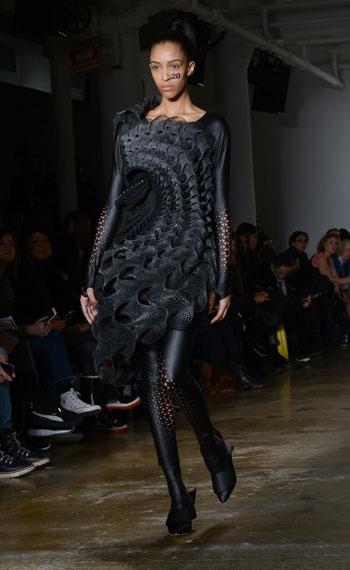The Pangolin and Harmonograph 3D printed dresses were shown during threeASFOUR’s AW16 runway show at Milk Studios, and form part of their new Biomimicry collection. ThreeASFOUR enlisted New York-based designer Travis Fitch to create these two remarkable dresses. Stratasys printed the pieces on an Objet500 Connex3 printer in their Nano Enhanced Elastomeric Technology material, set to be released later this year.
Always pushing the creative envelope, threeASFOUR is composed of designers Gabi Asfour, Angela Donhauser, and Adi Gil, and they are continually experimenting with using the natural geometries found in nature in their projects. The Harmonograph dress contours around the body in three spirals that follow the form of the Fibonacci sequence and visually portray a harmonograph, hence the moniker.
“Not only were the 3D printing capabilities of the Objet500 Connex3 essential in the production of the dress, but the entire design from its initial conception was intended to maximize the potentials inherent to this technology,” Gil explains. “The interwoven nature of the geometry could not be produced in a traditional manner, and it was critical to us that the design should evoke a language unique to 3D printing.”
The new Nano Enhanced Elastomeric Technology material allowed the designers to vary the flexibility of the material, creating rigidity where desired and softer portions for greater flexibility. This is especially evident in the Pangolin dress which was printed in 14 pieces and hand stitched together, combining the latest technology with traditional garment making.
Pangolins are strange looking South American mammals, otherwise know as scaly anteaters. The pangolin dress, like its namesake, features a chainmail-like series of scales. Due to the material properties of Stratasys’ Nano Enhanced Elastomeric Technology material and the design of the interlocking scales, this forms a novel textile.As Asfour explains, “This 3D printing allows us to create a new textile that does not exist. Especially on the Pangolin 3D printed dress, it’s about a chainmail type of textile where each unit is functioning by itself and it creates a four dimensional stretch – up and down, left and right, forwards and backwards. The most advanced textile prior to this was Lycra which is a 4-way stretch. So this is a whole new type of movement.”
Stratasys’ new material and the Objet500 Connex3 also allowed the designers to have control of subtle color variations through each piece. This, combined with the ability to vary the stiffness and flexibility throughout each dress, truly makes these designs a cut above the rest.
“Having the capability to vary color and rigidity in a single piece using Stratasys’ Connex3 3D printing technology inspired us to explore flexibility, depth and transformation as inherent design objectives,” comments Gil. “As artists and designers, it is our prerogative and our nature to explore the bounds of new technological opportunities, and to push the limits of the way in which forms are created. As the most advanced 3D printed dresses that we have created to date, we are extremely excited to showcase these pieces and demonstrate the unique possibilities unfolding at the intersection of fashion, design and technology.”
Below is a video about the creation of the Pangolin and Harmonograph dresses. What do you think of this new trend in fashion? Discuss in the 3D Printed Dresses forum over at 3DPB.com.
Subscribe to Our Email Newsletter
Stay up-to-date on all the latest news from the 3D printing industry and receive information and offers from third party vendors.
You May Also Like
3D Printing News Briefs, April 13, 2024: Robotics, Orthotics, & Hypersonics
In 3D Printing News Briefs today, we’re focusing first on robotics, as Carnegie Mellon University’s new Robotics Innovation Center will house several community outreach programs, and Ugogo3D is now working...
Rail Giant Alstom Saves $15M with 3D Printing Automation Software 3D Spark
3D Spark has entered into a three-year deal with the rail giant Alstom. Alstom, a transport behemoth with annual revenues of $16 billion, specializes in the manufacture of trains, trams,...
Meltio Expands Global Reach with New Partnerships in the Americas and Europe
Spanish 3D printing manufacturer Meltio has expanded its sales network across the globe. With the addition of three new partners in the United States, Brazil, Argentina, and Italy, Meltio aims...
3D Printing Webinar and Event Roundup: April 7, 2024
Webinars and events in the 3D printing industry are picking back up this week! Sea-Air-Space is coming to Maryland, and SAE International is sponsoring a 3D Systems webinar about 3D...

































